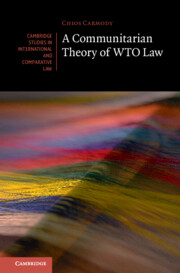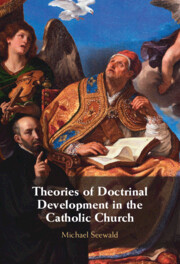Refine search
Actions for selected content:
95 results
Chapter 2 - The Dialectic of Freedom
- from Part I - Hegel, Freedom and Liberalism
-
- Book:
- Hegel Beyond Liberalism
- Published online:
- 27 September 2025
- Print publication:
- 16 October 2025, pp 37-60
-
- Chapter
- Export citation
4 - Dynamical systems as dependent lenses
- from Part I - The category of polynomial functors
-
- Book:
- Polynomial Functors
- Published online:
- 27 September 2025
- Print publication:
- 16 October 2025, pp 105-184
-
- Chapter
- Export citation
Introduction and Overview
-
- Book:
- The Psychology of System Change and Resistance to Change
- Published online:
- 23 September 2025
- Print publication:
- 09 October 2025, pp 1-2
-
- Chapter
- Export citation
6 - The Grounding Argument
-
- Book:
- Kant's Metaphysics of the Will
- Published online:
- 06 November 2025
- Print publication:
- 09 October 2025, pp 137-179
-
- Chapter
- Export citation

Polynomial Functors
- A Mathematical Theory of Interaction
-
- Published online:
- 27 September 2025
- Print publication:
- 16 October 2025
Chapter 27 - Boulez the Writer
- from Part V - Multiple Activities
-
-
- Book:
- Boulez in Context
- Published online:
- 08 July 2025
- Print publication:
- 24 July 2025, pp 285-292
-
- Chapter
- Export citation
Chapter 8 - Neurophilosophy
-
-
- Book:
- Essential Neuroscience for Psychiatrists
- Published online:
- 12 March 2025
- Print publication:
- 20 March 2025, pp 260-282
-
- Chapter
- Export citation
Chapter 14 - Is There a Future for the Philosophy of Nature?
- from Part IV - On Contemporary Challenges for the Philosophy of Nature
-
-
- Book:
- Hegel's <i>Philosophy of Nature</i>
- Published online:
- 19 December 2024
- Print publication:
- 12 December 2024, pp 273-292
-
- Chapter
- Export citation
4 - Traversing identities: navigating the self, school and system for culturally responsive pedagogies
- from Part 1 - Pedagogies for all
-
-
- Book:
- Teaching to Transform Learning
- Published online:
- 25 October 2024
- Print publication:
- 05 December 2024, pp 60-74
-
- Chapter
- Export citation
Rethinking International Order
-
- Journal:
- Ethics & International Affairs / Volume 38 / Issue 2 / Summer 2024
- Published online by Cambridge University Press:
- 22 November 2024, pp. 200-208
-
- Article
-
- You have access
- Open access
- HTML
- Export citation
10 - The Light of Nature and the Uses of Knowledge
- from Part V - Conclusion
-
- Book:
- Curating the Enlightenment
- Published online:
- 07 December 2024
- Print publication:
- 07 November 2024, pp 337-350
-
- Chapter
- Export citation
6 - Towards a Judicious Rapprochement
-
- Book:
- European Human Rights Grey Zones
- Published online:
- 18 April 2024
- Print publication:
- 25 April 2024, pp 185-228
-
- Chapter
- Export citation
1 - A Theory of WTO Law
-
- Book:
- A Communitarian Theory of WTO Law
- Published online:
- 14 December 2023
- Print publication:
- 21 December 2023, pp 1-54
-
- Chapter
- Export citation

A Communitarian Theory of WTO Law
-
- Published online:
- 14 December 2023
- Print publication:
- 21 December 2023
8 - The Idea of Commercial Society: Changing Contexts and Scales
- from Part II - Case Studies in the Digital History of Ideas
-
-
- Book:
- Explorations in the Digital History of Ideas
- Published online:
- 09 November 2023
- Print publication:
- 23 November 2023, pp 163-183
-
- Chapter
- Export citation
Chapter 3 - Against System
- from Part I - Approaches to the Corpus
-
- Book:
- How Plato Writes
- Published online:
- 27 July 2023
- Print publication:
- 17 August 2023, pp 52-70
-
- Chapter
- Export citation
Stanislavsky’s Failed Bildungsroman
-
- Journal:
- New Theatre Quarterly / Volume 39 / Issue 3 / August 2023
- Published online by Cambridge University Press:
- 28 July 2023, pp. 216-222
- Print publication:
- August 2023
-
- Article
- Export citation
1 - Systemic Functional Grammar
-
- Book:
- Systemic Functional Grammar
- Published online:
- 15 June 2023
- Print publication:
- 08 June 2023, pp 1-34
-
- Chapter
- Export citation
1 - Introduction to a Systemic Functional Grammar of Korean
-
- Book:
- Korean Grammar
- Published online:
- 16 March 2023
- Print publication:
- 23 March 2023, pp 1-16
-
- Chapter
- Export citation

Theories of Doctrinal Development in the Catholic Church
-
- Published online:
- 18 February 2023
- Print publication:
- 23 March 2023
